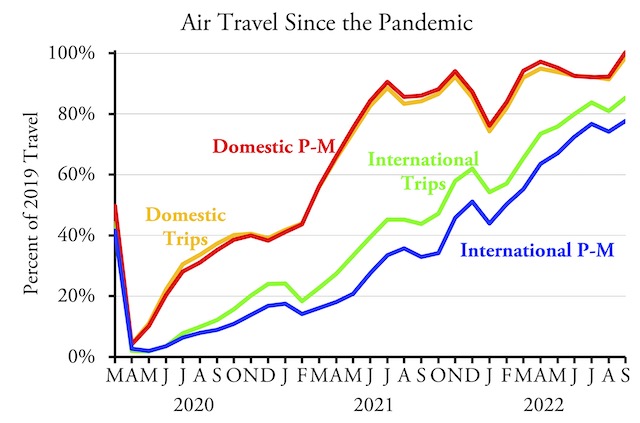In September 2022, Americans flew more domestic passenger-miles than the same month in 2019, according to data released yesterday by the Bureau of Transportation Statistics. This is the first time domestic air passenger-miles have exceeded 2019 levels since the pandemic began.
Although the number of passenger-miles exceeded 2019 levels, the number of trips was only 98.7 percent of September 2019. This indicates that people are substituting other means of travel for some shorter airline trips. The effect, however, is smaller than I would have expected: the average domestic airline trip was 926 miles in September 2022 vs. 911 miles in September 2019, or 1.7 percent longer. For 2022 to date, average trip lengths were only 1.4 percent longer than in the first nine months of 2019.
Domestic air travel has recovered despite the airlines flying fewer flights in 2022 than in 2019. In September, the airlines flew 12 percent fewer domestic flights than in September 2019. For the year to date, they’ve flown 13.5 percent fewer domestic flights than in the same months of 2019.
They’ve partly made up for this by flying larger planes: domestic seat-miles in September 2022 were 97.4 percent of September 2019. This still resulted in higher loads: 84.8 percent of seats were filled in September 2022 compared with 82.4 percent in September 2019. Social distancing was possible on the airlines during most of 2020, when only about half their seats were filled. Such distancing is no longer possible, but that doesn’t seem to be discouraging many potential air travelers.
Although domestic air travel has mostly recovered from the pandemic, international travel is still well below 2019 levels. September international air trips were 85 percent and passenger-miles were 78 percent of September 2019.
International trips are also markedly shorter than before the pandemic, though the difference has narrowed. In September, the average international trip was just under 3,300 miles, or 91 percent of the 3,600 miles in September 2019. This is an increase from January, when the average international trip was only 82 percent as many miles as in January 2019.
However, the ratio of 2022 to 2019 international air trip miles has hovered around 91 percent since June, making it appear that Americans are permanently avoiding longer trips. That may be due to other factors, however, such as the war in Ukraine and international tensions in other parts of the world. The movement of manufacturing jobs from China to Mexico will also make some business trips proportionately shorter.
Bureau of Transportation Statistics data also show that the airlines have become profitable again. They mostly lost money during the 2000s, mostly made money during the 2010s, and mostly lost money since 2020. However, domestic air flights earned overall profits during the second two quarters of 2022 while international flights were profitable in the third quarter of 2022.
Although the pandemic may have permanently altered the travel habits of some Americans, it appears that domestic air travel patterns have changed only slightly. The jury is still out on international travel, which is being influenced by factors that have little effect on domestic travel.









Back in the late 90s, early 2000s Boeing postulated and designed a new canard wing jetliner called the Sonic Cruiser…..
The idea was speed improvements came as a result of higher altitude flying (70,000 feet) but a new forced pressurized air breathing turbo fan engine….. these engines years later would become GE 90 series and its later GE -NX engines. The plane was supposed to carry 250 passengers and a range 7,500 miles with intercontinental ranges global point to point travel would reduce need follow thru airports or multiple flights.
After cancelation, later revamped which became the 787.
But airlines generally preferred lower operating costs to high speeds…